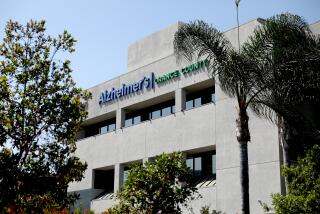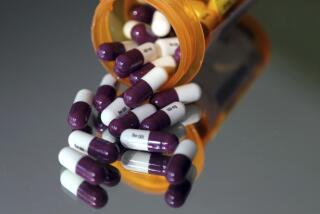Will ’98 Match Progress of 1997?
- Share via
The pharmaceutical field continues to bestow great gifts upon the American public. The progress in this field is apparent in this compilation of 1997 achievements from the Pharmaceutical Research and Manufacturers of America:
* The first new treatment in 14 years for congestive heart failure became available.
* Two protease inhibitors for children with HIV reached the market.
* The first therapy was approved to control certain severe epileptic seizures at home.
* Two new drugs to treat Parkinson’s disease were approved.
This year is also expected to produce many new products. According to PhRMA, researchers are working on 124 medications for AIDS and related conditions; 96 medications for heart disease and stroke; 316 cancer medicines; 178 medications for the debilitating diseases of aging; 373 drugs targeted for women; and 146 medications designed for children.
And, thanks to the Food and Drug Administration Modernization Act of 1997, new products should reach patients about a year sooner than has been typical.
Here’s a look at some likely developments for 1998.
Another SSRI Antidepressant Awaiting Approval
Selective serotonin reuptake inhibitors have now been available for more than 10 years. Since Prozac, the first SSRI, was introduced, several other similar drugs have become available. And yet another, slightly different, antidepressant is slated for approval in 1998.
Citalopram has been available in Europe for several years and is a best-selling antidepressant in several countries. The manufacturer, Forest Laboratories, filed a new drug application with the FDA last year and should receive clearance to market soon.
This medication should provide consumers with an attractive alternative because it is dissimilar, in several ways, from the other SSRIs. Citalopram has a different chemical structure and appears relatively free of drug-drug interactions, unlike several other of the SSRIs. It has been shown effective in treating anxiety and panic disorders and has even been shown to be beneficial for behavior disturbances related to dementia.
Progress on Oral Herpes
People with recurrent oral herpes simplex virus, known as the fever blister or cold sore, may soon have another option for treatment. Lidak, a biotech company in La Jolla, has requested clearance to market Lidakol. Lidakol is a topical cream that would be the first treatment for herpes outbreaks that, when used early enough, can abort further development of a recurrent herpes episode before it reaches the blister stage. The drug would be available by prescription only, although company officials say they hope to move the product to over-the-counter status as soon as the FDA permits.
As any herpes sufferer knows, anything to reduce the pain, itching, tingling and burning is a welcome relief. About 80% of adults are infected with herpes and about one-third of those who are infected have recurrent outbreaks. There is no cure for herpes. Over-the-counter products to relieve symptoms have traditionally been disappointing. The approval of Lidakol would be good news indeed.
An Herb Gets a Good Look
Fans of herbal remedies should applaud a study set to begin soon on the popular herb St. John’s wort. The herb, also called hypericum, is widely used in Europe to treat mild depression. Many U.S. consumers are enthusiastic about it, too, but there is a lack of American-produced data to support its effectiveness.
The federally funded study will be large enough to answer the basic question of whether St. John’s wort has antidepressant activity, according to a spokesman at the National Institute of Mental Health in Bethesda, Md. The study will be coordinated by researchers at Duke University and will include about 10 other research sites.
Vaccine for Rotavirus Should Win Approval
The first vaccine to prevent rotavirus gastroenteritis is likely to become available later this year. Rotavirus is the most common cause of severe diarrhea in children. It is highly contagious and sometimes fatal. About 50,000 children are hospitalized each year because of rotavirus infection.
An FDA advisory committee last month found the vaccine, which would be called RotaShield, to be safe and effective, clearing the way for its likely approval. Once approved, the vaccine may be recommended for all infants as part of the routine childhood immunization schedule.
The oral vaccine, manufactured by Wyeth-Ayerst, would be given in three doses at 2, 4 and 6 months of age. While the vaccine would fit nicely into the childhood immunization schedule (other vaccines are also given at 2, 4 and 6 months), there is concern about the overall crowding of the immunization schedule and parents’ enthusiasm for yet more vaccines.
High-Tech Medical Devices Should Assist Consumers
Medical professionals will soon have a safer method to draw blood from the finger. The Lasette, a battery-operated device for capillary blood collection, received FDA approval last year and will be widely available early this year. The Lasette uses a single pulse of laser light to draw blood, replacing the steel lancet.
The method has the advantage of reducing accidental sticks among workers and also causes less pain and soreness for the patient. The manufacturer, Cell Robotics International Inc., has plans to apply for an additional FDA clearance to allow diabetics to use the device for home blood tests.
Also in the category of reducing pain, research is advancing on ways to convert injection-only medications to oral formulations. One company, Emisphere Technologies Inc., is leading efforts to find ways to deliver proteins, such as insulin and human growth hormone, orally. The Hawthorne, N.Y., company may request approval to market its first such product--an oral heparin--this year. Heparin is an anticoagulant prescribed for a variety of cardiovascular conditions.
Also in the research pipeline are devices using biosensors that will allow consumers to perform many more medical tests at home. These products would reduce the time it takes for a commercial laboratory to perform a test. The devices are based on technology that allows certain biological particles to naturally find each other and react, or bind together. One such test, a kit for diabetics to measure their blood-sugar levels at home, is already available. But each year should produce several more devices for home testing, according to a recent report in the Sciences, the newsletter of the New York Academy of Sciences.






